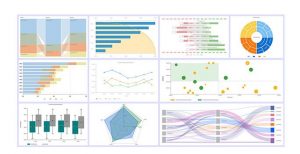The data analysis section of a nursing research paper is the heart of the study. It is where you present and interpret your findings, drawing meaningful conclusions from the data collected. A well-written data analysis section will not only showcase your research skills but also provide valuable insights for the nursing profession.
This guide will equip you with the necessary steps to effectively write and present an engaging nursing research paper data analysis.
The Essence of Data Analysis in Research Paper Writing
The essence of data analysis in research paper writing is transforming raw data into meaningful information that answers your research question and contributes to the broader field of study. It's not just about presenting numbers; it's about interpreting those numbers and their implications, drawing conclusions, and ultimately, making a contribution to knowledge.
Here's a breakdown of the core aspects:
- Understanding Your Data: The first step is to understand the nature of your data - its type, structure, and potential limitations. This allows you to choose the right analytical tools and interpret the results accurately.
- Choosing the Right Tools: Selecting appropriate data analysis techniques is crucial. These methods allow you to extract meaningful insights from the data, revealing patterns, relationships, and trends.
- Drawing Meaningful Insights: Data analysis isn't about just finding numbers; it's about finding meaning. This involves interpreting the results in the context of your research question, considering any potential biases or limitations, and drawing conclusions that contribute to the field.
- Presenting Your Findings: Communicating your analysis effectively is essential. This involves using clear language, visual aids (tables, graphs), and a logical structure that guides readers through the process of understanding your findings.
- Connecting to the Larger Picture: The data analysis section should not be seen as an isolated entity. It needs to be integrated into the broader research paper, linking back to the research question, literature review, and methodology.
Ultimately, the essence of data analysis in research paper writing lies in its ability to bridge the gap between raw data and meaningful knowledge. It's the process of transforming numbers and observations into insights that can inform practice, shape policies, and contribute to the advancement of a field.
Steps to Effective Nursing Research Paper Data Analysis
- Understanding the Purpose of Data Analysis in Nursing Research
The primary aim of nursing research paper data analysis is to transform raw data into meaningful information that can answer your research question and contribute to the broader field of nursing practice. It's not simply about presenting numbers; it's about interpreting those numbers and their implications for patient care.
Here's why the data analysis section is crucial:
- Provides a platform for evidence-based practice: The findings of your research should be used to support or challenge existing practices in the nursing profession.
- Identifies gaps in knowledge: Your analysis might reveal areas where further research is needed or suggest new approaches to existing problems.
- Offers valuable insights for improving patient outcomes: By analyzing the data, you can identify factors that impact patient care and recommend interventions to enhance quality and safety.
- Supports the overall research paper: It forms the core of your argument, providing evidence to support your claims and conclusions.
- Choosing the Right Data Analysis Techniques
The data analysis methods you employ will depend on the research question, type of data collected, and the desired outcome. Here's a breakdown of common techniques used in nursing research paper data analysis:

- Descriptive Statistics: Used to summarize and describe the basic characteristics of your data. This includes measures such as mean, median, mode, standard deviation, frequencies, and percentages.
- Inferential Statistics: Used to draw conclusions about a population based on a sample. This includes hypothesis testing, t-tests, ANOVA, regression analysis, and correlation analysis.
- Qualitative Data Analysis: Techniques used to analyze non-numerical data, such as interviews, focus groups, and observations. These methods often involve coding, thematic analysis, and identifying patterns in the data.
- Mixed Methods Analysis: Combining quantitative and qualitative data analysis to create a comprehensive understanding of the research question.
It is essential to select the most appropriate data analysis techniques for your study. Consulting with a statistician or researcher experienced in data analysis can be invaluable in choosing the right methods.
- Presenting Your Findings Effectively
The presentation of your nursing research paper data analysis should be clear, concise, and easy to understand. The following tips will help you effectively communicate your findings:
- Organize your data: Structure your data analysis section logically, following a clear narrative. Present your descriptive statistics first, followed by inferential statistics or qualitative analysis, as appropriate.
- Use tables and figures: Tables and figures are essential for presenting complex data visually. Ensure that these are well-labelled, easy to understand, and relevant to your analysis.
- Explain your findings thoroughly: Don't just present the numbers; explain what they mean in the context of your research question. Use clear and precise language to interpret your results.
- Discuss the limitations of your study: Acknowledge any limitations that may have affected your findings. This demonstrates transparency and strengthens the credibility of your research.
- Interpreting the Findings and Drawing Conclusions
The interpretation of your nursing research paper data analysis is crucial for drawing valid conclusions. This section requires careful reflection on the significance of your findings and their implications for nursing practice.
- Connect your findings to your research question: Clearly explain how your results answer your research question and contribute to the existing body of knowledge.
- Draw practical implications for nursing practice: Based on your findings, suggest how these insights can be applied to improve patient care, enhance nursing practice, or inform future research.
- Discuss the significance of your study: Highlight the impact of your findings on the field of nursing and how they contribute to evidence-based practice.
- Ethical Considerations in Data Analysis
Ethical considerations are paramount in nursing research paper data analysis. Here are some key points to keep in mind:
- Data privacy and confidentiality: Ensure the anonymity of participants and protect their data from unauthorized access.
- Transparency and honesty: Present your findings truthfully and avoid any bias or manipulation of data.
- Informed consent: Participants should be fully informed about the study and their rights before providing consent to participate.
- Data ownership and usage: Ensure proper attribution and compliance with research ethics guidelines for data ownership and usage.

- Common Mistakes to Avoid in Data Analysis
Avoid these common mistakes that can weaken the credibility of your nursing research paper data analysis
:
- Ignoring outliers or extreme values: These data points may indicate errors or unusual circumstances that need to be investigated.
- Overgeneralizing findings: Remember that your findings are based on a specific sample and may not be generalizable to all populations.
- Misinterpreting statistical significance: Statistical significance does not necessarily imply clinical significance.
- Ignoring limitations: Failing to acknowledge study limitations can undermine the credibility of your findings.
- Overstating the importance of your findings: Maintain objectivity and avoid exaggerating the impact of your research.
- Tips for Writing a Strong Data Analysis Section
Here are some tips to ensure a strong and impactful data analysis section in your nursing research paper:
- Focus on answering your research question: Every piece of data analysis should directly contribute to answering your research question.
- Use clear and concise language: Avoid jargon and technical terms that may be unfamiliar to your audience.
- Provide context for your findings: Explain the significance of your results within the broader context of nursing practice and existing literature.
- Use visuals effectively: Tables, figures, and graphs can help to clarify complex data and make your analysis more engaging.

- Proofread carefully: Ensure that your writing is error-free and adheres to the appropriate style guide.
Example: Data Analysis Section from a Nursing Research Paper
This example highlights a portion of a data analysis section from a hypothetical research paper:
Research Question: What is the impact of a new intervention on patient satisfaction with pain management in a hospital setting?
Data Analysis:
- Descriptive statistics: The study included 100 patients, 50 in the intervention group and 50 in the control group. The mean age of participants was 62 years (SD = 10).
- Inferential statistics: A paired t-test was conducted to compare patient satisfaction scores between the two groups. The results showed a significant difference in satisfaction scores between the intervention and control groups (t = 2.5, p = 0.01).
- Interpretation: The data suggests that the new intervention had a positive impact on patient satisfaction with pain management. Patients in the intervention group reported significantly higher satisfaction scores compared to those in the control group.
- Implications for practice: The findings suggest that the new intervention can be implemented to improve patient satisfaction with pain management in a hospital setting. Further research is recommended to explore the long-term impact of the intervention.
The data analysis section of your nursing research paper is a crucial element that provides evidence-based insights to improve patient care. By understanding the purpose, methods, and ethical considerations involved in nursing research paper data analysis, you can effectively present your findings and contribute to the advancement of the nursing profession. Remember to choose appropriate methods, present your findings clearly, interpret them thoughtfully, and avoid common mistakes. A well-written data analysis section will strengthen your research paper and ensure its impact on the field of nursing.
Get Professional Nursing Research Paper Writing Help
At
Academia Scholars, we offer professional research paper writing help for undergraduate, Degree, Master’s and Doctoral nursing programs. Our assistance covers topic suggestion, research paper writing, editing and proof reading, and plagiarism removal. Besides, we can also help you with
nursing essays, case studies and
dissertations.


